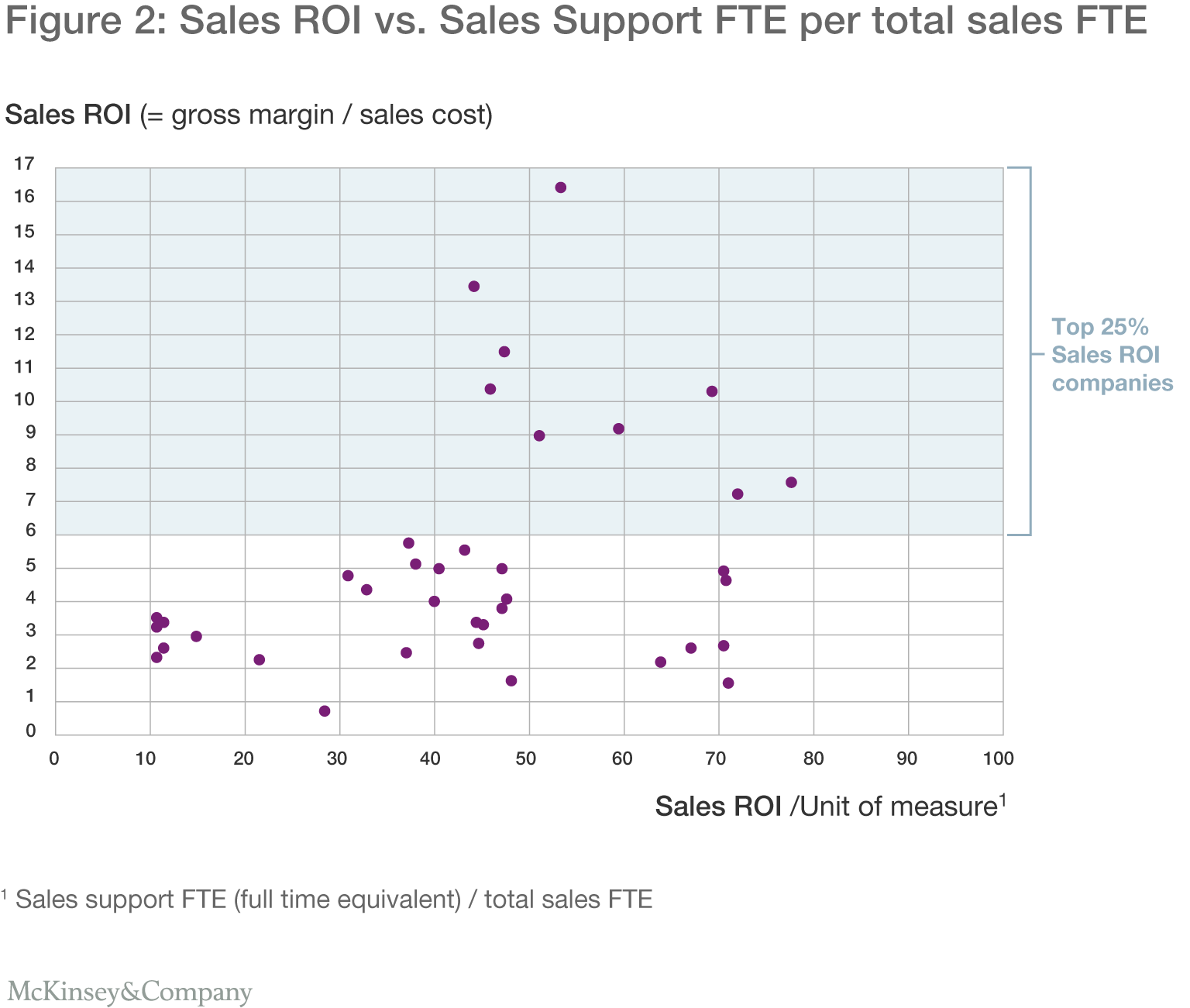Sales reps are most effective when they have the right amount of support, but exactly how much support staff does a company need, and how should the support be structured? Call it the Goldilocks quandary: too little support and your salespeople can’t do their jobs well; too much, and you’re wasting money. But get it just right, and your sales efforts can drive productivity and growth.
Our analysis indicates the answer is yes. By looking at detailed sales data from 40 companies in technology-related industries, we have identified guidelines for how much and what types of sales support and management are optimal. This includes all non-quota-carrying roles in the organization: customer-facing support, sales operations and administration, and sales management.
Evaluating our sample set of companies in hardware, machinery, industrial equipment, and information and communications technology, we have found a wide disparity in the amount of sales support that organizations employ. The efficiency of their sales departments, as measured by sales ROI1 also varies widely: the top 25 percent of companies we analyzed boast a sales ROI more than twice that of the bottom 25 percent. And these top performers have a 30 percent higher level of sales support than the rest of the companies.2 However, it is clear that having too high a share of sales support has a negative impact on sales ROI, as it simply increases the cost base without adding additional support to the front line. In fact, however, most of the companies with 60 to 80 percent sales-support ratios are in the bottom 75 percent range of sales ROI.
Getting the structure and ratio of your sales support just right depends on three things:
1. Hitting the sweet spot of sales support
We found that devoting 50 - 60 percent of sales employees to support functions is optimal. Many companies with low sales ROI devote fewer than 30 percent of their sales employees to support functions (see Exhibit).

Sales efficiency benefits from high support levels in two ways. First, support frees up front-line sales employees to be more productive. Consider that a typical sales rep at one of the top companies we analyzed generates USD 5.7 million in gross margin, versus just USD 1.7 million for the rest of the companies. Second, companies in the sweet spot of support have greater cost efficiency for their entire sales organization because sales support staff are usually paid less than front-line sales reps. In our analysis, the top companies had a 15 percent lower average cost per sales employee than their peers3 (an average of USD 168,000 per employee versus USD 199,000 for their peers).
2. Getting the right composition of sales support
The makeup of sales support is just as important as its quantity. We found that what matters most are the levels of operations and administrative support. The top-performing sales organizations have roughly the same share (30 percent) of customer-facing support as their peers, but twice the share of operations and administrative support (27 percent in top companies versus 12 percent in their peers).
Sales operations and administrative support are sometimes a victim of overly aspirational cost-saving efforts. Yet they are invaluable because they enable frontline and pre-sales employees to spend more time with customers and to focus on sales and growth.
3. Nailing the ratio of nonmanagers to managers.
Our analysis shows that the highest-performing companies have a ratio of nonmanagers to managers of around 8:1. Among lower-performing companies in our analysis, the ratio was greater than 10:1 or lower than 5:1.
When overseeing more than 10 people, a manager’s capacity to effectively supervise the sales staff decreases, dragging down ROI. On the other hand, managing fewer than four people translates into high costs (i.e., paying for more higher-wage managers).
Using digital to become “lean” across the entire sales process. Our experience has shown that maximizing the benefits of sales support requires companies to focus on building a fast-moving organization where some support activities are automated, streamlined, or cut entirely.
For example, companies can apply advanced analytic techniques, such as propensity-to-buy modeling and micromarket targeting, to help sales support staff do deal qualification much more efficiently. Digitizing sales planning is also a big opportunity to improve processes. One global high technology company digitized its sales planning process and reduced planning costs by 20%–25% in combination with 5% revenue growth through higher accuracy. Digitizing support activities can improve the process of matching sales bids with the right sales reps and reduce the required time spent per bid by up to 50%.
When a company gets these four things right, the results speak for themselves. The European sales organization of a global electronics brand saw impressive results when it committed to improving sales staffing ratios and digitizing sales support processes. Before the initiative, its sales reps were suffering from a lack of time for real selling. Up to 70% of their efforts were in administrative and back-office tasks. Additionally, there was no common sales support and management structure. Most sales support activities were performed independently and inconsistently for each country, resulting in a lack of standardization and repeated bid and proposal activities.
To change this, the company adjusted its sales support functions and manager oversight to the ideal ratios we’ve outlined. Sales leadership created a European shared service center and consolidated activities such as order handling, credit checking, license registration, receivables management, and invoicing. Other activities that required complex interactions with customers or quick turnaround times — such as lead qualification, disputes management, and credits management — were kept in local sales offices, where they would be closer to the customer. Time spent on customer-facing sales activities increased from 30% to around 50%.
The payoffs came in additional revenues and reduced costs. The company experienced a 5%–10% increase in win rates through improvements in customer satisfaction, and up to a 40% reduction in the time needed to close deals. Due to the bundling of tasks in the shared service center and the harmonization of tools and IT systems across markets, there was up to a 30% decrease in sales operations costs and a continuous annual productivity improvement of 2%–3%, especially in frontline activities.
Sales support is critical. Only by putting in place and optimizing the right types and levels of support can companies hope to get the greatest growth from their sales organization.
This article originally appeared on the Harvard Business Review site
- Sales ROI: The ratio of gross margin over total sales cost (personnel, non-personnel).
- “4 ways the best sales teams beat the market,” HBR blog, April 25, 2014.
- Full-time equivalent sales employee

